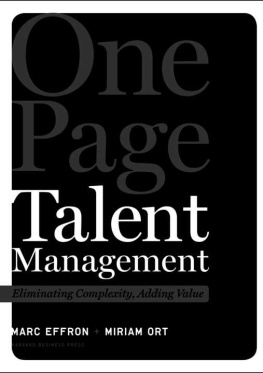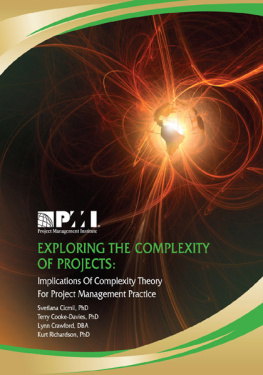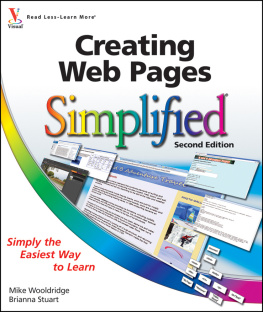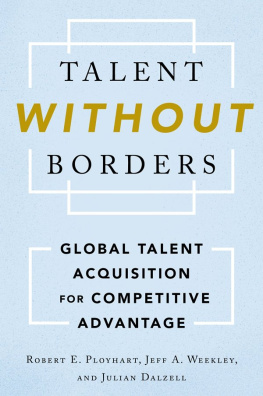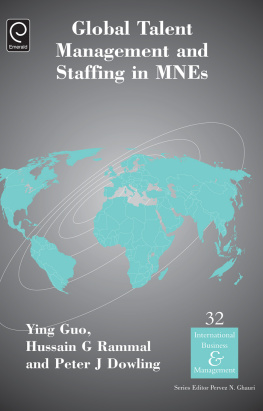Marc Effron - One Page Talent Management: Eliminating Complexity, Adding Value
Here you can read online Marc Effron - One Page Talent Management: Eliminating Complexity, Adding Value full text of the book (entire story) in english for free. Download pdf and epub, get meaning, cover and reviews about this ebook. year: 2010, genre: Business. Description of the work, (preface) as well as reviews are available. Best literature library LitArk.com created for fans of good reading and offers a wide selection of genres:
Romance novel
Science fiction
Adventure
Detective
Science
History
Home and family
Prose
Art
Politics
Computer
Non-fiction
Religion
Business
Children
Humor
Choose a favorite category and find really read worthwhile books. Enjoy immersion in the world of imagination, feel the emotions of the characters or learn something new for yourself, make an fascinating discovery.
- Book:One Page Talent Management: Eliminating Complexity, Adding Value
- Author:
- Genre:
- Year:2010
- Rating:4 / 5
- Favourites:Add to favourites
- Your mark:
- 80
- 1
- 2
- 3
- 4
- 5
One Page Talent Management: Eliminating Complexity, Adding Value: summary, description and annotation
We offer to read an annotation, description, summary or preface (depends on what the author of the book "One Page Talent Management: Eliminating Complexity, Adding Value" wrote himself). If you haven't found the necessary information about the book — write in the comments, we will try to find it.
Marc Effron: author's other books
Who wrote One Page Talent Management: Eliminating Complexity, Adding Value? Find out the surname, the name of the author of the book and a list of all author's works by series.
One Page Talent Management: Eliminating Complexity, Adding Value — read online for free the complete book (whole text) full work
Below is the text of the book, divided by pages. System saving the place of the last page read, allows you to conveniently read the book "One Page Talent Management: Eliminating Complexity, Adding Value" online for free, without having to search again every time where you left off. Put a bookmark, and you can go to the page where you finished reading at any time.
Font size:
Interval:
Bookmark:



MARC EFFRON + MIRIAM ORT
vii
1 1 1
In early 2006, when we began developing the approach that forms the basis of this book, setting a framework for talent management design was nowhere on our agenda. Our focus was completely practical. We had been asked to build and implement new talent management practices to support the turnaround of a $9 billion consumer products company. The company needed the practices quickly. It had to demonstrate results in a short time. What we delivered deviated from the more traditional views of how human resource (HR) and talent management practices should look and function. We had consciously worked to remove any extra features and complexity, while simultaneously trying to add value into each to make the practices more effective.
Although we were confident that these easier, value-adding practices would deliver superior results, early, reliable measures of our approach were still months away. However, in May 2007, a brief feature in the New Yorker gave us a little reassurance that we were onto something. The article described the problem of "feature creep"-the addition of tens or even hundreds of features to electronic devices like digital cameras. It said that engineers who were motivated to create cool, but not necessarily usable, technology were adding these extra features. At the other end of the product chain were consumers who were suffering from "feature fatigue," utterly confused about how to operate their devices due to the numerous options. A study on the topic showed that when given the choice, consumers most frequently selected the camera with the most features. However, when asked to use the camera they had selected, they quickly became frustrated and ultimately settled for a simpler design.' In short, while complexity was easy to make, market, and sell, complexity did not work.
We read that article and felt it was a perfect analogy for our design approach. The myriad options available in typical HR practices were the same as in a complicated camera-cool, but adding marginal value and complicating the overall experience. Rather than designing the typical camera, we had focused on making it usable, removing ten features but adding in autofocus so the user could achieve the core objective of taking better pictures. Complexity eliminated, value added.
How We Got Here
That design approach and this book describing it results from a culmination of experiences rather than a blinding flash of inspiration. For Marc, the foundational experience occurred when he was a young political consultant in Southern California using a simple approach to help small-town water board, school board, and city council candidates win elections. The consulting firm he worked for believed that candidates won elections for two reasons only-high personal trust and high name recognition. It felt that a candidate should focus exclusively on maximizing those two factors and had developed a consulting approach to achieve that.
As a candidates' consultant, Marc would tell them exactly how to increase personal trust and name recognition, with every instruction focusing on a few, powerful levers for victory. Among other things, they would learn the size, color, and copy for their campaign signs (three feet by five feet, blue letters on white background, name and position only) and get the exact script they were to use when talking to voters. All this advice was captured in a twenty-page booklet he gave to candidates.
What activities were the candidates prohibited from? Anything that wasn't proven to work, including distributing potholders, running radio ads, and hosting or attending wine and cheese parties. The victory rate for Marc's candidates was about mid 80 percent. The candidates learned two clear lessons-what is simple works, and avoid distractions.
After a business school career change, for the next twenty years, Marc had broad exposure through corporate and consulting experiences to what worked and did not work in growing talent. As the leadership consulting practice leader for Hewitt Associates, one of the world's largest HR consultancies, Marc saw what made talent practices work in hundreds of organizations worldwide. And, from more than three years of the Top Companies for Leaders Study that he created in 2001, he was able to extract from the data of more than six hundred companies, the three key elements that allowed them to consistently grow great talent.2 One of those elements was that companies that consistently produced great earnings and great talent did not have the most sophisticated or most complex talent processes. Instead, they had processes that fit their culture, were relatively simple, and were flawlessly executed.
Marc started with Avon Products in late 2005, just prior to the launch of its turnaround effort. He sought an opportunity to approach talent management in a new way, applying the sum of his experiences, and this was it. Miriam Ort was a manager on his talent management team and a five-year Avon veteran. In the years leading up to Avon's turnaround efforts, she had seen an organization flush with cash and touting double-digit growth that was unable to take advantage of several appealing acquisitions due to limited bench. At the same time, the organization had rolled out a number of new talent practices, some even written up as best practices. Somehow, the beautifully designed and well-benchmarked processes were not translating into the bottom-line talent depth Avon so desperately needed. This lesson underscored the need for the usable, outcome-oriented processes that were later embodied in our approach.
As we worked to redesign Avon's talent practices, our combined experiences gave us a strong point of view about how talent should be grown. The result was a structured approach and philosophy for building talent that we call One Page Talent Management (OPTM).
One Page Talent Management
OPTM is a radical departure from typical corporate talent development processes. Its goal is straightforward-increase talent depth and quality in the simplest, easiest way possible. We believe that can be accomplished only by creating the shortest path from the proven behavioral science to the desired business outcome. This book details exactly how to do that by starting with the science, eliminating complexity, and adding value to each process. We also describe how to maximize the effectiveness of each process by making it transparent and ensuring accountability for its execution.
Our approach is not a set of best practices, and we do not believe that there is one best version of any talent process. Although we provide an example in each chapter of what an OPTM-inspired process could look like, you might follow our design process and reach a completely different result. We suggest that, given that your business challenges, leaders, and values are likely different from ours, your results should not look like the generic examples we present.
Font size:
Interval:
Bookmark:
Similar books «One Page Talent Management: Eliminating Complexity, Adding Value»
Look at similar books to One Page Talent Management: Eliminating Complexity, Adding Value. We have selected literature similar in name and meaning in the hope of providing readers with more options to find new, interesting, not yet read works.
Discussion, reviews of the book One Page Talent Management: Eliminating Complexity, Adding Value and just readers' own opinions. Leave your comments, write what you think about the work, its meaning or the main characters. Specify what exactly you liked and what you didn't like, and why you think so.

